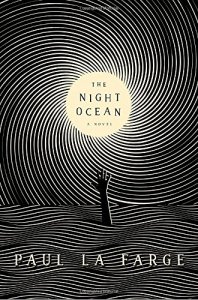Paul Di Filippo reviews Paul La Farge
The Night Ocean, by Paul La Farge (Penguin 978-1-101-98108-5, $27, 400pp, hardcover March 2017
 I initially became aware of the work of Paul La Farge with the publication of his first novel, An Artist of the Missing, which I reviewed for the much-missed Realms of Fantasy magazine in the year 2000. I followed that up with a discussion of his second book, Haussmann, or the Distinction, in that same venue in 2002. Both books, I thought, were superb. Slipstream fantastika through and through, though obviously not genre.
I initially became aware of the work of Paul La Farge with the publication of his first novel, An Artist of the Missing, which I reviewed for the much-missed Realms of Fantasy magazine in the year 2000. I followed that up with a discussion of his second book, Haussmann, or the Distinction, in that same venue in 2002. Both books, I thought, were superb. Slipstream fantastika through and through, though obviously not genre.
But then, as these things so often happen, I veered away from his new output due simply to pressures of time, never reading novels three and four: The Facts of Winter and Luminous Airplanes. My loss, I am quite sure.
But then, at Necronomicon in 2015, I got to spend some time with the author, and learned that his fifth book was in progress. The next year, I actually heard him read a portion of it when he appeared at Brown University. I knew then I’d have to cover it, due to its quality and topic. Put most simplistically, it’s a novel examining the friendship between H. P. Lovecraft and his teenage pal, Robert Barlow, who became HPL’s literary executor. But it’s also much more than that, as we shall see.
We start out in a manner which instantly informs us that La Farge has done his literary homework and is going to produce a book that follows (when it is not deliberately twisting) the formalistic conventions of an HPL tale, as well as the thematic and conceptual guideposts. The book opens with the first person voice of one Marina Willett, describing how her likely-driven-insane husband, Charlie, has escaped from a sanitarium and presumably drowned himself in a nearby lake. Quintessential start to a Mythos tale. But for some reason not totally clear to Marina herself, or yet to us, she believes he is still alive.
And so she begins to lay out the incidents and obsessions of Charlie’s late-period life for us, circa 2007 to 2012. A writer of biographical portraits, Charlie got interested in Lovecraft and his pal Barlow. He began to do research, eventually stumbling upon the existence of a secret diary from HPL dubbed the Erotonomicon. Sure enough, when the book eventually falls into Charlie’s hands, it proves to be the lustful account of HPL’s gay sex life, including incidents, most importantly, with the adolescent Barlow. Charlie also discovers that the Erotonomicon caused a scandal in fandom and the real world that left a visible historical, journalistic record which time has merely buried.
From here he tracks down the publisher of the book, and discovers that it was all a hoax, perpetrated by a fanboy named L. C. Spinks! This revelation and sleuthing allows Charlie to produce a best-selling book of his own, exposing the hoax and restoring HPL’s posthumous reputation. (Does all this fit interstitially into our continuum, or are we dealing with a counterfactual timeline? Such a question is merely part of the tightrope La Farge expertly dances along.)
Now the plot begins to get even more complicated, and I believe I need to cease revealing any more of it, and might even now have said too much. Suffice it to disclose that La Farge’s narrative course takes him into a beautiful, anthropologically thick rendition of 1950s Mexico, via Barlow, including the presence of one William Burroughs; into the social set of the Futurians; into the contemporary literary scene in New York; into the flaming ruins of Europe circa 1945; into Greenwich Village in the late 1940s; and into a handful of other evocatively rendered and nigh-tangible milieus. It all culminates beautifully and with suitable mystery in Florida during the present-day, near Barlow’s ancestral digs.
Throughout the book, Marina’s distinctive voice comes to the surface, then sinks deep below, as various other points of view rise to the fore. She is depicted with grace and precision and complexity. One tends to think of Oedipa Maas in The Crying of Lot 49. A bricolage of documents, as in Lovecraft’s preferred mode, delivers ambiguous information. Trapdoors of truth and hoax open up beneath the feet of Marina and the reader. And issues of identity confusion multiply faster than in a Christopher Priest novel. In fact, the only overt supernaturalism relates to identity, namely in the realms of possession and transmigration.
Nor does La Farge stint his confrontation of HPL’s worst character traits. This book is totally au courant with all the controversies, but comes down on no particular ideological side. As Charlie himself says, a black man justifying his own interest in HPL: “If I give up on all the racists, there won’t be anyone left!”
With its deft and tactful employment of many real-life figures, including some still living, such as S. T. Joshi, this book resembles a little the two pulp thrillers by Paul Malmont, The Chinatown Death Cloud Peril and The Astounding, the Amazing, and the Unknown. But ultimately La Farge has bigger fish to fry, since he is concerned with the stories we tell ourselves to hide our existential fears. When the stories fail, then we get a glimpse of the fabled “cosmic horror” that haunted HPL, that burbling, bubbling, baffling chaos at the center of creation.
Part of the HPL “revival” that includes recent work by Matt Ruff, Nick Mamatas and Victor LaValle, La Farge’s book succeeds admirably in broadening our understanding of HPL and his whole circle, while humanizing the man and his peers, as it delves into the core reasons why HPL’s work fascinates us. Of course, the eldritch mind games this fine novel deploys and its diabolical undermining of consensual reality, leading to the derangement of readers everywhere, is mere icing on the cake!






